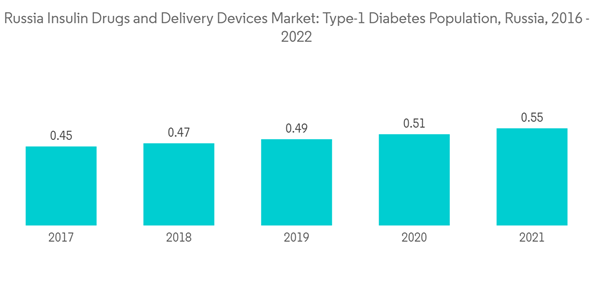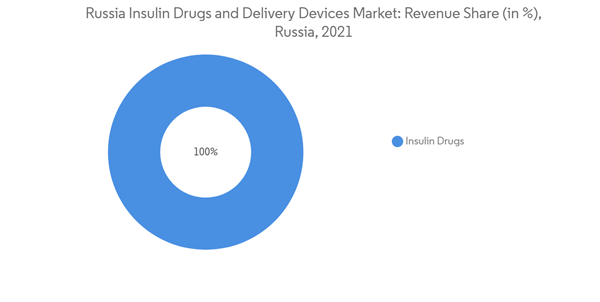The COVID-19 pandemic has resulted in premature deaths, particularly among the elderly, in its first year of existence. Russia has the ninth-highest number of confirmed COVID-19 cases in the world. The majority of COVID-19 deaths were caused by the co-occurrence of two or more chronic conditions in the same person. Several studies have found that chronic diseases such as diabetes are linked to poor outcomes in COVID-19 patients.
Diabetic drugs are medications designed to stabilise and control blood glucose levels in diabetics. Diabetic drugs have been proposed as potential treatments for diabetic patients infected with SARS-CoV-2 during the COVID-19 pandemic. The rapidly increasing incidence and prevalence of diabetic patients, as well as healthcare expenditure, indicate that diabetic care products are being used more frequently. According to Roscongress, Russia ranks fifth in the world in terms of the number of people aged 20 to 79 who have diabetes mellitus. Furthermore, during COVID-19, the mortality rate among diabetic patients increased by 22%.
The World Health Assembly agreed on a Resolution to strengthen diabetes prevention and control in May 2021. It suggests actions such as increasing insulin access, promoting convergence and harmonisation of regulatory requirements for insulin and other diabetes medicines and health products, and assessing the feasibility and potential value of establishing a web-based tool to share information relevant to market transparency for diabetes medicines and health products.
As a result of the aforementioned factors, the studied market is expected to grow during the analysis period.
Russia Insulin Drugs & Delivery Devices Market Trends
Growing Diabetes and Obesity Population in Russia
In recent years, Russia has seen an alarming increase in the prevalence of diabetes. Patients with diabetes must make numerous adjustments throughout the day to maintain nominal blood glucose levels, such as taking anti-diabetic medication or eating more carbohydrates while monitoring their blood glucose levels. Obesity, an unhealthy diet, and physical inactivity are all contributing to an increase in newly diagnosed Type 1 and Type 2 diabetes cases.According to IDF, the Russian government must fully implement a National Diabetes Plan that establishes a state budget that guarantees diabetes care to all Russian citizens in order to reduce the country's diabetes epidemic. Russia is working to improve the reimbursement system for all aspects of diabetes care, with the goal of limiting out-of-pocket payments and preventing households from incurring catastrophic costs. Implementing a national screening programme to improve early detection of disturbed carbohydrate metabolism, as well as establishing a specialised diabetes health service under the Russian Federation's Ministry of Health.
Because of the aforementioned factors, the market is expected to expand further.
The Insulin Pumps Segment is Expected to Witness Highest Growth Rate Over the Forecast Period
An insulin pump is a device, which delivers insulin continuously or whenever required automatically. The pump mimics the human pancreas. The insulin infusion pump works as an alternative to the traditional system of daily injections or an insulin pen. Insulin Pump held a major market share in the insulin delivery devices market in 2021 and is expected to grow with a CAGR of more than 4.3% in the market during the forecast period because of the increasing technological advancement and its preference over other traditional methods due to continuous insulin administration. Insulin pump therapy is a well-established insulin administration method for type 1 diabetes (T1DM) people. Pumps are a validated, time-tested therapeutic option in T1DM at all ages, enabling near-physiological insulin delivery in situations where the pancreas does not produce insulin. There are even pump models with remote controls enabling parents of young children to either suspend or bolus insulin from a distance when the child is playing or eating. The insulin infusion pumps reduce the large swings in blood glucose levels, induce less pain, and deliver more accurately when compared to injections. These advantages of insulin pumps over the traditional delivery system are expected to boost the market.According to the Moscow Times, more than 90% of diabetes expenditures go toward treating diabetes-related complications. According to Russia's Federal Targeted Diabetes Program, detecting diabetes and treating its complications earlier can result in significant savings. Several initiatives are being launched in the country to combat diabetes. For example, at the Moscow Urban Forum 2021, a Letter of Intent was signed between the Moscow Department of Health's Youth Council, the Moscow Urban Forum, the Moscow Diabetic Association, the Moscow Diabetic Association Medical Section, KB Strelka, and Novo Nordisk to implement the Cities Changing Diabetes program in Moscow. The Moscow program aims to conduct a comprehensive assessment of the characteristics of diabetes challenges that are relevant to Moscow, as well as to develop an action plan to combat this disease among the most vulnerable groups of the population.
The introduction of numerous new products increased international research collaborations in technological advancement and increased public awareness of diabetes are some of the market opportunities for Russian market participants.
Russia Insulin Drugs & Delivery Devices Industry Overview
Russia Insulin Drugs and Delivery Devices Market is consolidated, with few significant and generic players. Mergers and acquisitions that happened between the players in the recent past have helped the companies strengthen their market presence. Eli Lilly and Boehringer Ingelheim together have an alliance in developing and commercializing Basaglar (Insulin Glargine). Additionally, the players in the recent past helped the companies strengthen their market presence; for example, Novo Nordisk collaborated with Ypsomed to provide better insulin therapy solutions.Additional Benefits:
- The market estimate (ME) sheet in Excel format
- 3 months of analyst support
This product will be delivered within 2 business days.










